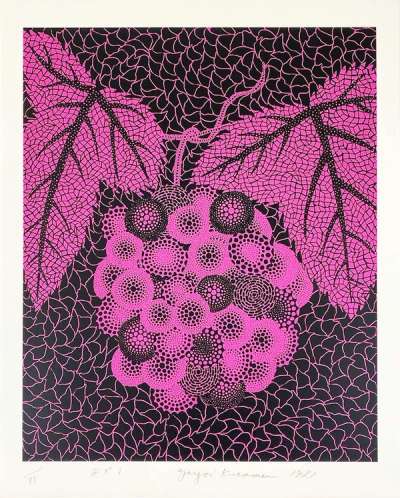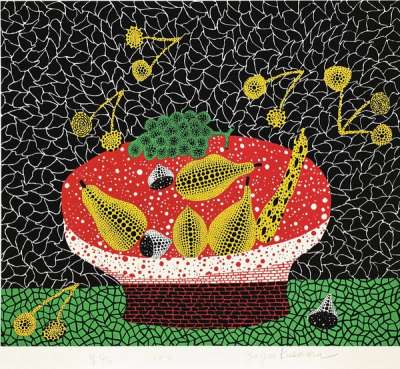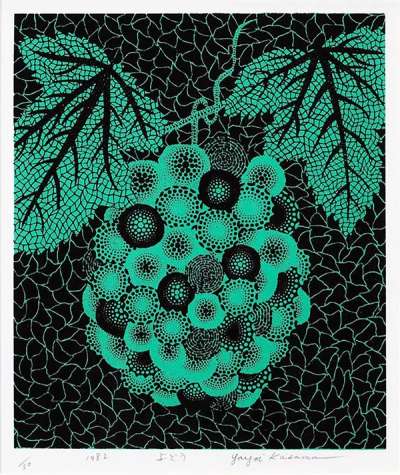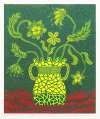Fruit
Yayoi Kusama’s prints featuring fruits explore the spatial representation through her signature dots. By arranging her dots directionally and according to size, she effectively evokes the dimensionality of the fruit, on a block colour background. Kusama’s love of fruits and vegetables stems from her parent’s employment as seed sellers.
Yayoi Kusama Fruit For sale
Fruit Value (5 Years)
With £94542 in the past 12 months, Yayoi Kusama's Fruit series is one of the most actively traded in the market. Prices have varied significantly – from £818 to £31250 – driven by fluctuations in factors like condition, provenance, and market timing. Over the past 12 months, the average selling price was £15757, with an average annual growth rate of 20.68% across the series.
Fruit Market value
Auction Results
| Artwork | Auction Date | Auction House | Return to Seller | Hammer Price | Buyer Paid |
|---|---|---|---|---|---|
 Pumpkin And Fruits Yayoi Kusama Signed Print | 19 Jul 2025 | Mainichi Auction, Osaka | £12,750 | £15,000 | £17,000 |
 Fruits Yayoi Kusama Signed Print | 28 Jun 2025 | Neww Auction | £10,625 | £12,500 | £14,500 |
 Fruits Yayoi Kusama Signed Print | 5 Jun 2025 | Phillips London | £11,900 | £14,000 | £19,000 |
 Grapes In The City Yayoi Kusama Signed Print | 26 Jan 2025 | SBI Art Auction | £12,750 | £15,000 | £18,000 |
 Grapes Yayoi Kusama Signed Print | 25 Oct 2024 | SBI Art Auction | £13,600 | £16,000 | £19,000 |
 Grapes Yayoi Kusama Signed Print | 15 Jul 2023 | SBI Art Auction | £21,250 | £25,000 | £29,000 |
 Grapes Yayoi Kusama Signed Print | 16 Jul 2022 | SBI Art Auction | £22,100 | £26,000 | £29,000 |
Sell Your Art
with Us
with Us
Join Our Network of Collectors. Buy, Sell and Track Demand
Meaning & Analysis
Fruit, vegetables, and fruit baskets are a staple motif in the oeuvre of Japanese artist Yayoi Kusama. This collection gathers prints depicting fruit, often in bold monotone or primary colours, using both Kusama’s famed polka dot and net patterns.
Kusama was familiar with varieties of fruit and vegetables (including, of course, Pumpkins) and the human dependence on the natural world that an agricultural upbringing implies, coming from a family that cultivated vegetable seeds for its living. It is no wonder then, that in these prints she leans into the art historical tradition of the still life, which has historically used fruit as an allegorical key. Ripe fruit conventionally connotes wealth, vitality and moral fortitude, and rotting fruit is a symbol of corruption. In these prints, Kusama’s fruit is sumptuous and richly coloured, evoking a grateful, celebratory mood.
Between 1982-3, and later in 1989, Kusama produced a number of screen-prints that focus solely on grapes. Pictured on a large scale and replete with vine leaves, Kusama's grapes hold their own particular symbolism within the classical genre of the still life. Thanks to their association with wine and boozy Mediterranean evenings, they are convey abundance, monetary wealth, and fertility. Particularly given the cosmopolitan skyline in the background of Grapes In The City, it seems Kusama captures some of the glamour and party atmosphere of the milieu, and of her own life at the time; it was around the 1980s that Kusama’s art began to gain really spectacular momentum in Japan, leading to commissions, exhibits and TV appearances. Yet perhaps, as with much of Kusama’s symbolism, it is not quite that straightforward. Taking into account that Kusama voluntarily checked herself into a psychiatric hospital in Tokyo in 1977, where she has since lived, it is possible that the lifestyle her increased fame promised was a daunting and bittersweet prospect.
Above all, these prints showcase Yayoi Kusama’s innovation, as she subverts the traditionalism of the genre of the still life, moving away from the realism of the old master’s paintings and finding her own way to evoke depth and form. She uses her iconic dots motif to give roundness to her grapes, cleverly concentrating larger dots towards the centre of the circle and radiating smaller dots away from this point, effectively portraying a sphere.


















